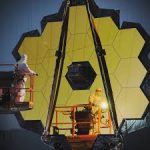

Space
NASA’s newest space observatory could sniff exoplanet atmospheres for signs of life
Over the course of our existence, humanity has struggled to definitively answer the question: “Are we alone?”
Is Earth the only planet in the vast cosmic sea that contains life? As our technology becomes more advanced, we get closer and closer to the answer.
Our solar system contains a multitude of worlds, planetary bodies ranging from ice planets to gas giants with magnificent rings to rocky, terrestrial worlds like our own. But what lies out beyond our stellar neighborhood?
It’s only been in the last few decades that scientists have detected planets orbiting other stars. We call them exoplanets. Since that initial discovery, researchers have trained their telescopes on the cosmos in search of new and different worlds.
Their efforts were not in vain, as thousands of exoplanets have been detected. Now, scientists are starting to shift their focus to the individual planets and learning as much as they can about them. Do they contain life? What are they made of? What kind of atmosphere do they have?
These are the types of questions we hope to answer about the alien worlds that fill our universe.
One element essential to life on Earth is oxygen. Its presence is what scientists refer to as a biosignature. (These are the types of things NASA’s next Mars rover will look for.) A recent paper published in Nature Astronomy details a new technique that scientists are hoping will help them detect the presence of oxygen in exoplanet atmospheres.
Like methane, oxygen is a biosignature but its presence does not guarantee we will find life. There are plenty of non-biological processes that produce oxygen (as well as methane). However, if other biosignatures are detected in addition to oxygen, the chances of life increase significantly.
NASA’s Curiosity rover detected a methane cycle on Mars that varies with the seasons. However, its orbital counterparts — European spacecraft TGO and Mars Express — have not. The science team is working to identify what is causing the methane spikes as well as why it seems to disappear as it rises through the atmosphere.

“Oxygen is one of the most exciting molecules to detect because of its link with life, but we don’t know if life is the only cause of oxygen in an atmosphere,” Edward Schwieterman, an astrobiologist at UC Riverside and co-author on the study, said in a statement. “This technique will allow us to find oxygen in planets both living and dead.”
The new method was developed by a team led by Thomas Fauchez, a planetary scientist at NASA’s Goddard Space Flight Center. It is derived from the behavior of oxygen molecules in Earth’s atmosphere.
When oxygen molecules collide, they produce a signal—a very subtle dip in infrared radiation. Unfortunately, that signal is so faint that current observatories cannot detect it in distant planets. But that will soon change. NASA’s latest and greatest telescope, the James Webb Space Telescope (JWST) will come online sometime in the next few years. Fauchez’s team has shown that JWST, which will observe the universe in the infrared, should have what it takes to spot it.
- When NASA’s James Webb Space Telescope comes online, it will help us identify the best planets to look for life. Credit: NASA
- The Mars 2020 rover now has an offical name: Perseverance. Credit: NASA/JPL-Caltech
“Before our work, oxygen at similar levels as on Earth was thought to be undetectable with Webb,” said Fauchez in a statement. “This oxygen signal is known since the early 1980s from Earth’s atmospheric studies but has never been studied for exoplanet research.”
In the meantime, NASA’s Mars 2020 rover will launch to the red planet in July. Once it’s on Mars, it will study Jezero Crater, the site of an ancient river delta and scan the region for signs of life (like oxygen, methane, and other biosignatures). The rover will also bag up bits of Mars to be returned to Earth at a later date.

News
SpaceX shades airline for seeking contract with Amazon’s Starlink rival

SpaceX employees, including its CEO Elon Musk, shaded American Airlines on social media this past weekend due to the company’s reported talks with Amazon’s Starlink rival, Leo.
Starlink has been adopted by several airlines, including United Airlines, Qatar Airways, Hawaiian Airlines, WestJet, Air France, airBaltic, and others. It has gained notoriety as an extremely solid, dependable, and reliable option for airline travel, as traditional options frequently cause users to lose connection to the internet.
Many airlines have made the switch, while others continue to mull the options available to them. American Airlines is one of them.
A report from Bloomberg indicates the airline is thinking of going with a Starlink rival owned by Amazon, called Leo. It was previously referred to as Project Kuiper.
American CEO Robert Isom said (via Bloomberg):
“While there’s Starlink, there are other low-Earth-orbit satellite opportunities that we can look at. We’re making sure that American is going to have what our customers need.”
Isom also said American has been in touch with Amazon about installing Leo on its aircraft, but he would not reveal the status of any discussions with the company.
The report caught the attention of Michael Nicolls, the Vice President of Starlink Engineering at SpaceX, who said:
“Only fly on airlines with good connectivity… and only one source of good connectivity at the moment…”
CEO Elon Musk replied to Nicolls by stating that American Airlines risks losing “a lot of customers if their connectivity solution fails.”
American Airlines will lose a lot of customers if their connectivity solution fails
— Elon Musk (@elonmusk) December 14, 2025
There are over 8,000 Starlink satellites in orbit currently, offering internet coverage in over 150 countries and territories globally. SpaceX expands its array of satellites nearly every week with launches from California and Florida, aiming to offer internet access to everyone across the globe.
Currently, the company is focusing on expanding into new markets, such as Africa and Asia.
News
Tesla hints at Starlink integration with recent patent
“By employing polymer blends, some examples enable RF transmission from all the modules to satellites and other communication devices both inside and outside the vehicle.”

Tesla hinted at a potential Starlink internet terminal integration within its vehicles in a recent patent, which describes a vehicle roof assembly with integrated radio frequency (RF) transparency.
The patent, which is Pub. No U.S. 2025/0368267 describes a new vehicle roof that is made of RF-transparent polymer materials, allowing and “facilitating clear communication with external devices and satellites.”
Tesla believes that a new vehicle roof design, comprised of different materials than the standard metallic or glass elements used in cars today, would allow the company to integrate modern vehicular technologies, “particularly those requiring radio frequency transmission and reception.
Tesla has recently filed a US patent application on integrating RF transparent materials into the roof structure.
“facilitating clear communication with external devices and satellites”
Tesla fleet is getting @Starlink connectivity integration soon. LFG @Tesla @elonmusk… pic.twitter.com/bLa8YtPLd1
— Chansoo Byeon (@Chansoo) December 9, 2025
Instead of glass or metallic materials, Tesla says vehicles may benefit from high-strength polymer blends, such as Polycarbonate, Acrylonitrile Butadiene Styrene, or Acrylonitrile Styrene Acrylate.
These materials still provide ideal strength metrics for crashworthiness, stiffness for noise, vibration, and harshness control, and are compliant with head impact regulations.
They would also enable better performance with modern technologies, like internet terminals, which need an uninterrupted signal to satellites for maximum reception. Tesla writes in the patent:
“By employing polymer blends, some examples enable RF transmission from all the modules to satellites and other communication devices both inside and outside the vehicle.”

One of the challenges Tesla seems to be aware of with this type of roof design is the fact that it will still have to enable safety and keep that at the forefront of the design. As you can see in the illustration above, Tesla plans to use four layers to increase safety and rigidity, while also combating noise and vibration.
It notes in the patent that disclosed examples still meet the safety requirements outlined in the Federal Motor Vehicle Safety Standards (FMVSS).
Starlink integrated directly into Tesla vehicles would be a considerable advantage for owners. It would come with a handful of distinct advantages.
Initially, the inclusion of Starlink would completely eliminate cellular dead zones, something that is an issue, especially in rural areas. Starlink would provide connectivity in these remote regions and would ensure uninterrupted service during road trips and off-grid adventures.
It could also be a critical addition for Robotaxi, as it is crucial to have solid and reliable connectivity for remote monitoring and fleet management.
Starlink’s growing constellation, thanks to SpaceX’s routine and frequent launch schedule, will provide secure, stable, and reliable internet connectivity for Tesla vehicles.
Although many owners have already mounted Starlink Mini dishes under their glass roofs for a similar experience, it may be integrated directly into Teslas in the coming years, either as an upgrade or a standard feature.
Investor's Corner
SpaceX IPO is coming, CEO Elon Musk confirms
However, it appears Musk is ready for SpaceX to go public, as Ars Technica Senior Space Editor Eric Berger wrote an op-ed that indicated he thought SpaceX would go public soon. Musk replied, basically confirming it.

Elon Musk confirmed through a post on X that a SpaceX initial public offering (IPO) is on the way after hinting at it several times earlier this year.
It also comes one day after Bloomberg reported that SpaceX was aiming for a valuation of $1.5 trillion, adding that it wanted to raise $30 billion.
Musk has been transparent for most of the year that he wanted to try to figure out a way to get Tesla shareholders to invest in SpaceX, giving them access to the stock.
He has also recognized the issues of having a public stock, like litigation exposure, quarterly reporting pressures, and other inconveniences.
However, it appears Musk is ready for SpaceX to go public, as Ars Technica Senior Space Editor Eric Berger wrote an op-ed that indicated he thought SpaceX would go public soon.
Musk replied, basically confirming it:
As usual, Eric is accurate
— Elon Musk (@elonmusk) December 10, 2025
Berger believes the IPO would help support the need for $30 billion or more in capital needed to fund AI integration projects, such as space-based data centers and lunar satellite factories. Musk confirmed recently that SpaceX “will be doing” data centers in orbit.
AI appears to be a “key part” of SpaceX getting to Musk, Berger also wrote. When writing about whether or not Optimus is a viable project and product for the company, he says that none of that matters. Musk thinks it is, and that’s all that matters.
It seems like Musk has certainly mulled something this big for a very long time, and the idea of taking SpaceX public is not just likely; it is necessary for the company to get to Mars.
The details of when SpaceX will finally hit that public status are not known. Many of the reports that came out over the past few days indicate it would happen in 2026, so sooner rather than later.
But there are a lot of things on Musk’s plate early next year, especially with Cybercab production, the potential launch of Unsupervised Full Self-Driving, and the Roadster unveiling, all planned for Q1.










